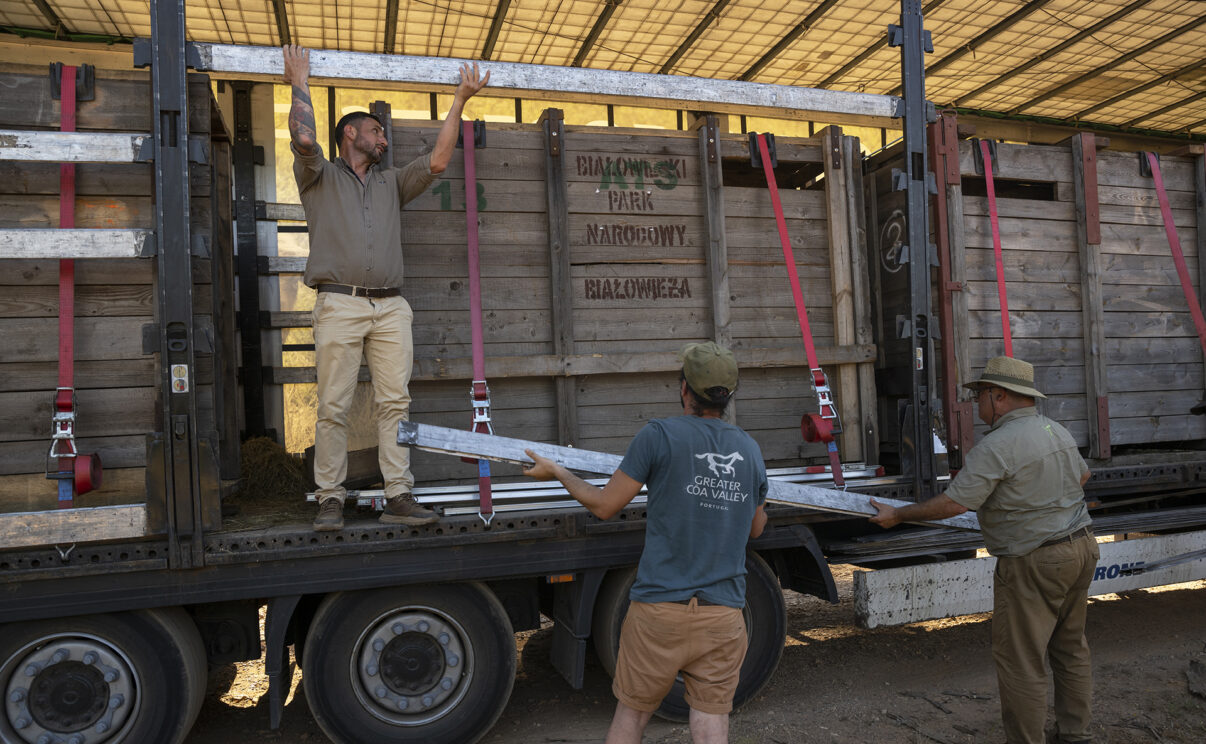A herd of eight European bison have simply arrived on the Herdade do Vale Feitoso Property in Portugal. Managed in cooperation with the Rewilding Portugal staff, they are going to improve carbon sequestration, enhance biodiversity, and help the expansion of nature-based tourism.
João Cosme
Pioneering translocation
A herd of eight European bison have arrived on the 7600-hectare Termas de Monfortinho and Herdade do Vale Feitoso property, situated within the Castelo Branco District, south of the Better Côa Valley rewilding panorama. The translocation of the bison, which have been sourced from reserves throughout Poland – by the Polish State Forest and European Pals Society, and with the help of the European Bison Conservation Middle (EBCC) – is being partially funded by a grant from Rewilding Europe’s European Wildlife Comeback Fund. That is the first-ever translocation of European bison to Portugal. The translocation can also be being sponsored by a partnership with wine-producing firm Altas Quintas, which is elevating funds for threatened wildlife species.
Roaming throughout a part of the property, the bison will promote biodiversity and assist the panorama to lock up extra atmospheric carbon. As massive grazers, the animals will decrease the chance of catastrophic wildfire by lowering flammable vegetation, creating pure firebreaks, and opening up forested areas, which allows extra mild and permits grass to develop as a substitute of scrub. Outbreaks of catastrophic wildfire have gotten more and more frequent throughout Mediterranean areas as local weather change results in extra excessive temperatures. This drawback is compounded as shrubs encroach on areas the place livestock have disappeared on account of rural depopulation.

João Cosme
A progressive pilot
The European bison can be managed in cooperation with the Rewilding Portugal staff. They may share the panorama with a herd of Tauros, which had been translocated to the Better Côa Valley in 2023 and not too long ago moved to the property. As soon as the bison have acclimatised to their new environment folks can be allowed to view them, with a member of the Wild Côa Community – a community of greater than 50 nature-based companies in and across the Better Côa Valley – set to organise excursions.
“We’re viewing this translocation as a pilot,” explains Rewilding Portugal staff chief Pedro Prata. “The bison can be intently monitored to see how they acclimatise to the native panorama and local weather. That is the primary time that Rewilding Portugal staff have managed bison, so it’s a studying course of for us too. Members of the staff will obtain coaching in bison administration.”

João Cosme
The European bison: a local weather, biodiversity and group hero
As a keystone and flagship rewilding species, the European bison has the potential to be each a local weather and biodiversity hero. This is among the explanation why the continuing comeback of this influential herbivore in European landscapes, coupled with efforts to help inhabitants progress, is so essential.
By means of their grazing, foraging, trampling and fertilising, bison assist to keep up biodiversity-rich mosaic landscapes of forest, scrub, and grassland, in addition to quite a few micro-habitats, which host a variety of plant and animal species. This has been highlighted by research in Europe, in addition to in North America with regard to the associated American bison. These similar interactions can enhance the seize of atmospheric carbon in each vegetation and the soil, with carbon additionally saved within the our bodies of the bison themselves. By supporting the expansion of nature-based tourism, European bison could be group heroes too.

João Cosme
Historic context
Whereas the European bison has not been recorded naturally on the Iberian Peninsula, stays of the now extinct steppe bison – from which all residing bison at this time are descended – have been recorded within the area. Steppe bison turned extinct round 10,000 years in the past after the final ice age, however the European bison – which coexisted with steppe bison for tens of hundreds of years in Europe – unfold east throughout Europe so far as the Volga River and Caucasus Mountains. On the Iberian Peninsula, European bison carry out the same ecological operate because the steppe bison as soon as did, with current analysis exhibiting that the species is adapting properly to Mediterranean climates in Spain.
European bison themselves had been pushed to the sting of extinction by searching and habitat loss. When the final wild European bison was shot within the Caucasus in 1927, there have been solely 54 European bison left alive, all in captivity. Due to conservation efforts, the species has since made a outstanding comeback. During the last decade, the variety of European bison has elevated from simply over 2500 to round 9000 people.
Rewilding Europe’s efforts have seen European bison populations established in Romania’s Southern Carpathians and Bulgaria’s Rhodope Mountains. We’re additionally supporting their comeback within the Oder Delta (Germany and Poland).

Nelleke de Weerd
Let’s rewild collectively
The agile setup of the European Wildlife Comeback Fund is designed to help wildlife comeback in a handy and versatile means. Rewilding Europe invitations different initiatives working to ascertain and reinforce populations of keystone species in European landscapes to think about making use of for a grant.
These excited by contributing to wildlife restoration in Europe can help wildlife comeback with a web based donation. For those who’d like to take a position greater than 50,000 euros within the European Wildlife Comeback Fund, we’d like to get in contact with you personally.

Nelleke de Weerd

















